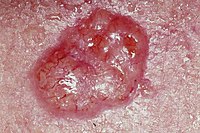
Photo from wikipedia
Protein-encapsulated gold nanoclusters (Au NCs) have recently gained much attention in biosensing and bioimaging applications owing to their remarkable fluorescence properties, nontoxicity and good biocompatibility. In this work, the mannose… Click to show full abstract
Protein-encapsulated gold nanoclusters (Au NCs) have recently gained much attention in biosensing and bioimaging applications owing to their remarkable fluorescence properties, nontoxicity and good biocompatibility. In this work, the mannose was grafted onto the bovine serum albumin (BSA) encapsulated Au NCs (BSA-Au NCs) to produce a mannose functionalized BSA-Au NCs (Man-BSA-Au NCs) as a new fluorescence probe for Concanavalin A (Con A) detection and human breast cancer cell imaging. A new strategy with mannose-BSA conjugates as template was firstly applied for the synthesis of Man-BSA-Au NCs, leading to a high loading of mannose (767.6 ± 7.2 mg/L) onto BSA-Au NCs. The as-prepared Man-BSA-Au NCs showed advantages of facile preparation, good monodispersity and strong red-emission. Notably, aggregation-induced fluorescence quenching of Man-BSA-Au NCs was triggered by Con A due to the multivalent cooperative interactions between mannose and Con A, which was subsequently confirmed by MALDI-TOF MS. Hence highly selective and sensitive fluorescence detection of Con A was achieved by using Man-BSA-Au NCs as a fluorescence sensor. A good linear relationship was obtained over the range of 0.01-1 μM (R2 = 0.994) with a detection limit of 0.62 nM (S/N = 3). The developed sensor was then applied to determine Con A in human serum with acceptable recoveries of 93.70-104.8%. Moreover, based on the specific recognition between mannose and overexpressed mannose receptors on human breast cancer cells, the Man-BSA-Au NCs were successfully utilized for cancer cell imaging with good specificity.
Journal Title: Talanta
Year Published: 2020
Link to full text (if available)
Share on Social Media: Sign Up to like & get
recommendations!